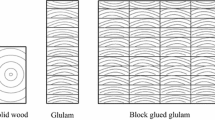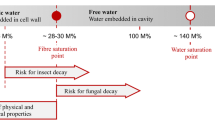Abstract
The evaluation of damages in large-span timber structures indicates that the predominantly observed damage pattern is pronounced cracking in the lamellas of glued-laminated timber elements. A significant proportion of these cracks is attributed to the seasonal and use-related variations of the internal climate within large buildings and the associated inhomogeneous shrinkage and swelling processes in the timber elements. To evaluate the significance of these phenomena, long-term measurements of climatic conditions and timber moisture content were taken within large-span timber structures in buildings of typical construction type and use. These measurements were then used to draw conclusions on the magnitude and time necessary for adjustment of the moisture distribution to changing climatic conditions. A comparison of the results for different types of building use confirms the expected large range of possible climatic conditions in buildings with timber structures. Ranges of equilibrium moisture content representative of the type and use of building were obtained. These ranges can be used in design to condition the timber to the right value of moisture content, in this way reducing the crack formation due to moisture variations. The results of this research also support the development of suitable monitoring systems which could be applied in the form of early warning systems on the basis of climate measurements. Based on the results obtained, proposals for the practical implementation of the results are given.












Similar content being viewed by others
References
Blaß HJ, Frese M, Schadensanalyse von Hallentragwerken aus Holz (2010) Band 16 der Reihe Karlsruher Berichte zum Ingenieurholzbau. KIT Scientific Publishing, Karlsruhe
Frühwald E, Serrano E, Toratti T, Emilsson A, Thelandersson S (2007) Design of safe timber structures—how can we learn from structural failures in concrete, steel and timber? Report TVBK-3053. Div. of Struct. Eng, Lund University, Lund
Dietsch P, Winter S (2009) Assessment of the structural reliability of all wide span timber structures under the responsibility of the city of Munich. Proceedings 33rd IABSE symposium. Bangkok, Thailand, pp 9–11
Dietsch P (2012) Einsatz und Berechnung von Schubverstärkungen für Brettschichtholzbauteile. Dissertation, Technische Universität München
EN 1995-1-1:2004 (2004) Eurocode 5: design of timber structures—part 1-1: general—common rules and rules for buildings. European Committee for Standardization CEN, Brussels, Belgium
Blaß HJ, Ehlbeck J, Kreuzinger H, Steck G (2004) Erläuterungen zu DIN 1052:2004–08. Bruderverlag, Karlsruhe
Meierhofer U, Sell J (1979) Physikalische Vorgänge in wetterbeanspruchten Holzbauteilen—2. und 3. Mitteilung, Holz als Roh- und Werkstoff, 37 (6 + 12), pp 227–234 and 447–454
Krabbe E, Neuhaus H (1989) Über Konstruktion. Klima und Holzfeuchtigkeit eines Hallenbades, Bauen mit Holz 91(4):214–217
Koponen S (2002) Puurakenteiden kosteudenhallinta rakentamisessa. TKK-TRT report 1-0502, Helsinki
Evans F, Kleppe O, Dyken T (2007) Monitoring of timber bridges in Norway—results. Report Norsk Treteknisk Institutt, Oslo
Feldmeier F (2007) Ergebnisse und Schlussfolgerungen aus den Felduntersuchung einer Eissporthalle, Tagungsband Ingenieurholzbau—Karlsruher Tage, pp 98–104
Brischke C, Rapp AO (2007) Untersuchung des langfristigen Holzfeuchteverlaufs an ausgewählten Bauteilen der Fußgängerbrücke in Essing. Arbeitsbericht der Bundesforschungsanstalt für Forst- und Holzwirtschaft, Hamburg
Marquardt H, Mainka G-W (2008) Tauwasserausfall in Eissporthallen. Bauphysik 30(2):91–101
Niemz P, Gereke T (2009) Auswirkungen kurz- und langzeitiger Luftfeuchteschwankungen auf die Holzfeuchte und die Eigenschaften von Holz. Bauphysik 31(6):380–385
Fragiacomo M, Fortino S, Tononi D, Usardi I, Toratti T (2011) Moisture-induced stresses perpendicular to grain in cross-sections of timber members exposed to different climates. Eng Struct 33(11):3071–3078
Fortino S, Genoese A, Genoese A, Nunes L, Palma P (2013) Numerical modelling of the hygro-thermal response of timber bridges during their service life: a monitoring case-study. Construct Build Mater 47:1225–1234
Klaiber V (2003) Dimensionsstabilität von Fichtenholz unter dem Einfluss verschiedener Varianten der Rundholzbereitstellung und Schnittholztrocknung—Untersucht an Beispiel eines Fichtenreinbestandes in Mittelgebirgslage. Dissertation, Albert-Ludwigs-Universität, Freiburg im Breisgau
EN 14080 (2013) Timber structures—glued laminated timber and glued solid timber—requirements. CEN, Brussels
Gamper A, Dietsch P, Merk M, Winter S (2012) Building climate—long-term measurements to determine the effect on the moisture gradient in timber structures. Final report, Lehrstuhl für Holzbau und Baukonstruktion, Technische Universität München
Ressel JB (2006) Fundamentals of wood moisture content measurement. Course notes, COST E53 Training School “Methods for measuring of moisture content and assessment of timber quality”, BFH, Hamburg, October 17–19
Dietsch P, Franke S, Franke B, Gamper A (2014) Measurement of moisture content in timber structures—methods (this issue)
Euler L (1755) Institutiones Calculi differentialis, Berlin
Kollmann F, Coté WA (1968) Principles of wood science and technology I: solid wood. Springer, Berlin
Fortuin G (2003) Anwendung mathematischer Modelle zur Beschreibung der technischen Konvektionstrocknung von Schnittholz. Dissertation, Universität Hamburg
Keylwerth R, Noack D (1956) Über den Einfluß höherer Temperaturen auf die elektrische Holzfeuch- tigkeitsmessung nach dem Widerstandsprinzip. Holz als Roh- und Werkstoff 14(5):162–172
Hailwood AJ, Horrobin S (1946) Absorption of water by polymers: analysis in terms of a simple model. In: Transactions of the Faraday Society, vol 42b, pp 84–92
Simpson WT (1973) 1973. Predicting equilibrium moisture content of wood by mathematical models, wood and fiber science 5(1):41–48
Acknowledgments
The research project was kindly supported by the following partners from industry: Scanntronik Mugrauer, DE-Zorneding; Studiengemeinschaft Holzleimbau e.V., DE-Wuppertal, bauart Konstruktions GmbH+Co. KG, DE-Lauterbach, Konstruktionsgruppe Bauen AG, DE-Kempten. Special gratitude is extended to the Research Initiative “Future Building” for funding the project with financial means of the Federal Office for Building and Regional Planning. In addition, the authors wish to acknowledge the help of students Michael Kraus, Manuel Waidelich, Stephanie Riedler und Astrid Indefrey during the reading and charting of data.
Author information
Authors and Affiliations
Corresponding author
Rights and permissions
About this article
Cite this article
Dietsch, P., Gamper, A., Merk, M. et al. Monitoring building climate and timber moisture gradient in large-span timber structures. J Civil Struct Health Monit 5, 153–165 (2015). https://doi.org/10.1007/s13349-014-0083-6
Received:
Revised:
Accepted:
Published:
Issue Date:
DOI: https://doi.org/10.1007/s13349-014-0083-6




